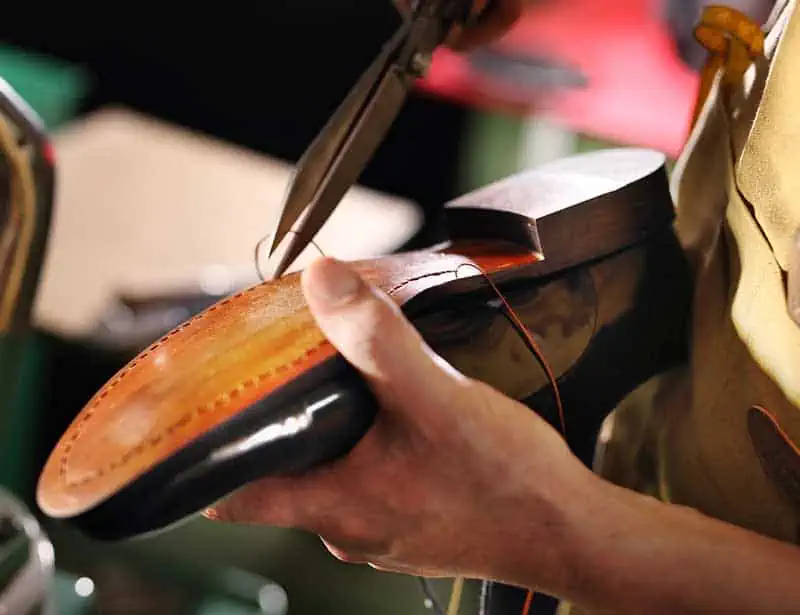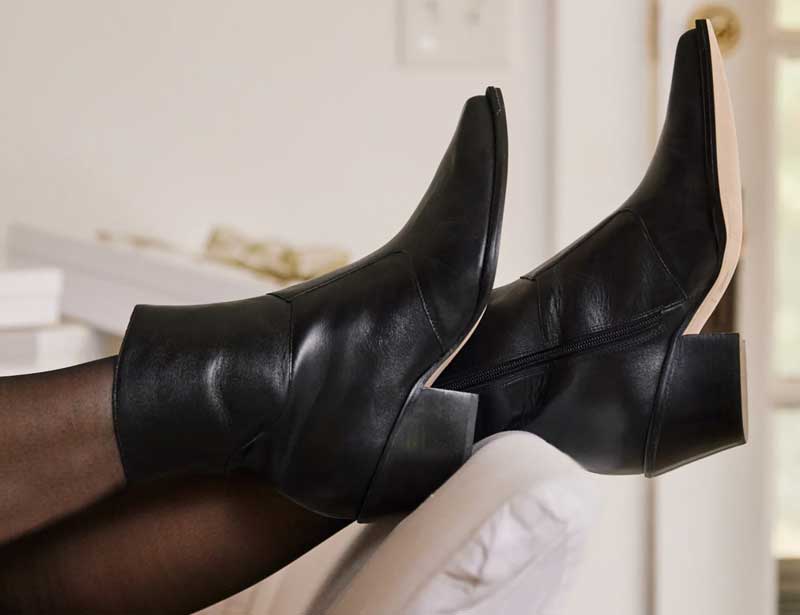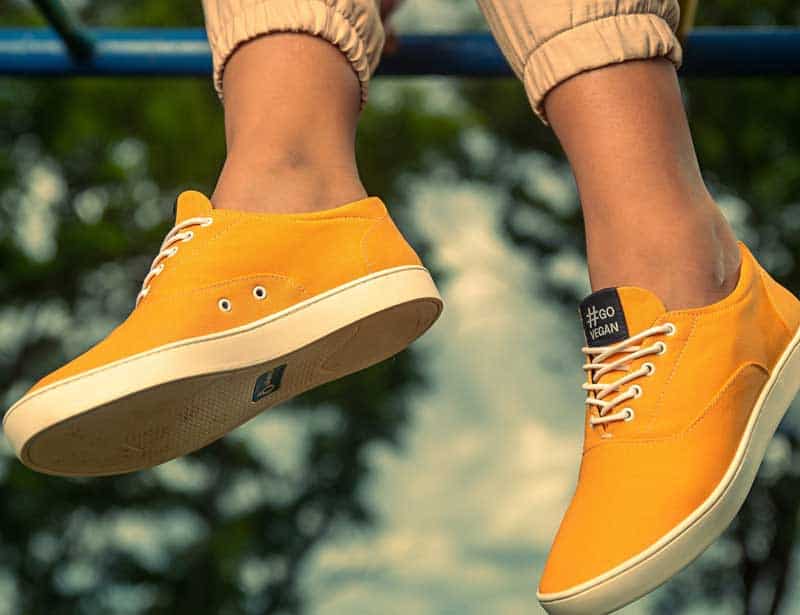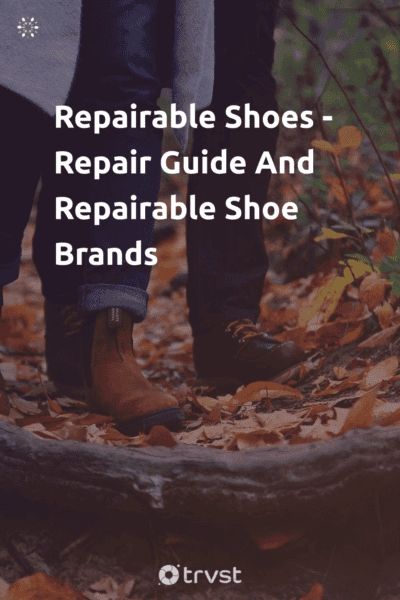Guide To Repairable Shoes For Longer-Lasting Kicks
Our shoes work hard; they protect our feet, support, and bear the brunt of gravitational friction. Shoes seem to succumb to wear and tear easily, but you can extend the life of your kicks by choosing repairable shoes.
However, some shoes are more amenable to repair than others. Repairable shoes can accommodate various types of repairs, including total replacement of the sole or upper parts.
In this article, we share which kinds of shoes are repairable and why repairing shoes is better for the environment. Or, if that pair of shoes has become a little tired, you might also like to check out our ideas for upcycling shoes to give them a new lease of life.
Why choose repairable shoes?

There was once a time when repairable shoes were the order of the day. These shoes could last for decades, passed on to others when the owners grew out of them. But with fast fashion, we now have cheaper options with use spans of around a year or less.
Here are some reasons to buy a repairable shoe.
Reduce your carbon footprint
Every time you buy a pair of new shoes, there's a carbon footprint attached. How big or small that footprint gets depends on how they were made, how long you use the shoes, and what you do with them when you no longer want them.
With repairable shoes, it's easier to use them for a longer time and reduce your carbon footprint significantly.
Landfill saving
Thanks to fast fashion, the useful life of fashion items has become relatively short. The world sends 75% of textile waste to landfills2; only 25% is recycled or reused.
We know landfill spaces are not infinite; they'll overflow if we don't reduce waste generation. Repairable shoes stay out of landfills for longer and prevent unnecessary waste of landfill space.
Related: Fast fashion facts and statistics
Slow fashion consumption
Manufacturing shoes have an impact on the environment. From sourcing raw materials to transportation to fabrication, the process consumes natural resources and releases CO2. The global shoe industry contributes 8% of greenhouse gas emissions1.
Shoes that can be repaired or fixed last longer encourage buying fewer shoes, which slows down fashion consumption. A slower consumption rate means less pollution and resource consumption by shoe manufacturers.
Related: What is slow fashion?
Easier than recycling
Non-repairable shoes are usually made of many materials, such as fabric, foam, and leather fused. Items with composite materials are harder to recycle because each material must be separated before recycling. For those reasons, a lot of shoes don't get recycled.
Therefore, it is so much easier to repair shoes than to recycle them. And you know that not all shoes qualify for repair, so buy a repairable shoe from the get-go.
Saves you money
Everyone would like a chance to save money on purchases. But instead of jumping at two for the price of one fashion deal, buy high-quality, repairable shoes. And when it comes time for a few fixes, repairing your shoes costs less than purchasing a whole new pair of shoes.
Is repairing shoes good for the environment?

Repairing shoes is better than throwing them away. But you might wonder if restoring shoes negatively impacts the environment.
The simple answer is yes; cobblers work on one shoe at a time. They use minimal equipment and do not generate a lot of waste. A cobbler will likely save tiny strips of leather and other materials for future use; large shoe factories don't have time for that.
Regarding shoe-making materials like glue, wax, leather, fabric, etc., you only need a small quantity for shoes repaired by hand. Also, you or the cobbler can source eco-friendly options locally.
What shoes can be repaired?
All shoes can be repaired, but that depends on the degree of damage. Fixing a small hole or a little color bleeding in any shoe is possible. However, major shoe repairs like sole replacements are only possible with some types of shoes.
When we say repairable shoes, we use shoes whose soles and heels can be replaced as a benchmark. The soles and heel tips are usually the first things to wear out.
Consider the material
High heels, dress shoes, sandals, dress boots, flats, leather boots, and loafers are extensively repairable shoes. The way they are designed and the material choice contribute to this.
Genuine or faux leather shoes are usually more amenable to repairs as leather is a durable and sturdy material. It is easy to get factory-quality leather locally and replace damaged parts. Suede, cork, wood, and natural rubber also hold up to shoe repairs.
Construction quality matters
The shoe quality is also a strong determinant of whether the shoe will stand up to repair. High-quality shoes are more likely to be made so that they are repairable; we cannot say the same for cheap shoes.
High-quality dress shoes, for example, are made with Goodyear welt construction. A Goodyear welt is a strip of leather that goes around the bottom edge of the shoe. It attaches to both the insole and the upper. Cobblers can easily unstitch the strip to replace the sole without damaging the shoe.
The Blake stitch construction is a close competitor to the Goodyear welt. It is also easy to take apart, but some think it could be more durable.
Repairable shoes may be slightly more expensive, but they are smart investments. They offer a long period of use and save you the cost of buying new shoes as the heels, soles, or uppers of your show wear out.
Non-repairable shoes
We don't consider sneakers as repairable shoes. For one, sneaker soles are injection molded, and they don't sell them separately. So, unless your local cobbler has an injector mold and consent from the brand, they have no way to replace sneaker soles.
Usually, sneaker soles are melded to the upper parts, so taking them apart for repairs causes further damage. However, some sneaker soles are just glued on. But the best you can do is glue it back if it falls off or breaks.
Also, they typically combine different materials, including fabrics, leather, plastic, etc., to create the upper parts of sneakers. That makes it almost impossible to replace the upper parts of sneakers.
However, we can opt for sneakers made from more sustainable materials regarding most footwear choices. Check out our guide to sustainable sneaker brands for some of the better options out there.
What to do with shoes that can't be repaired

Sometimes, you need a type of shoe type that is outside the repairable category. The trash bin is one of many options when they are old. Below are some sustainable alternatives.
Donate to charity
A faulty buckle or stain may ruin your favorite pair of shoes for you, but it may help someone else in need. You can donate old shoes in reasonably good condition to charity.
The charity organization may sell them, use the proceeds for community projects, or give the shoes directly to needy people. Oxfam, Soles4Souls, and HavASole are some charities you can consider.
Or if they’re in good enough condition, you might also choose to resell them at an online thrift store or local second-hand store.
Donate them to a cobbler
Sometimes, your old shoe is too far gone for someone else to wear. But the local cobbler can get buckles, straps, patches, and other useful bits from them.
Use Terracycle
There's a high chance that shoes aren't curbside recyclable where you like. You'll need to send your old shoes to recycling companies like Terracycle. You can use earth911 to search for recycling centers around you that accept shoes.
Use the brand's take-back program
Some brands take back old products for recycling. They sometimes give store credit to customers who try to send their shoes back.
For example, any Nike store would take any athletic shoe off your hands. The brand recycles its old shoes into material for track and playground surfacing.
How do you repair shoes?
You have three options and they are;
Do it yourself
You can repair your shoes. Some shoes come with preconstructed removable and replaceable parts like heels. They make it so you can fix it at home without heavy equipment.
Also, there are some fixes that you can do yourself—for example, dyeing your stained or faded shoes a darker color.
The best part about repairing shoes by yourself is how creative you can get. You can even give your shoe a new look with DIY hacks.
Find a cobbler

Cobblers specialize in repairing shoes; you can often source great handmade shoes from them too. They mostly work on leather, but they may also be able to fix up other types of shoes. You can simply search to find cobblers near you on the internet.
Here is a list of shoe repairs a cobbler can help you with.
- Replacement of worn-out soles, heels, or heel tips.
- Slightly stretch out tight areas of a shoe, like the toe box.
- Apply dye to fading leather or suede shoes.
- Shorten, lengthen, or sew on straps of strappy shoes or sandals.
- Adding new insoles or padding existing ones for comfort.
- Repairing stitching and re-gluing loose parts.
- Replace parts of shoes damaged by a pet's chewing.
- Fix scuffed or stained leather, suede, and other shoe materials.
- Lower the height of heeled shoes or boot shafts.
Additionally, a cobbler can shine your shoes and install rubber soles to make them more durable and weatherproof. However, they can not make dark shoes lighter or make a shoe a different size.
Use the shoe brand's repair service
Many sustainable footwear brands include shoe repair services in their offerings. That way, they ensure that their shoes last as long as they created them to do.
Some shoe brands offer a free repair service, while others require payment. Paying for branded repairs might be more expensive than a local cobbler, but they use branded parts. That way, your repaired shoe comes back as good as new.
Eight repairable shoe brands
If you are looking for a good pair of shoes you won't have to toss when the heel gets choppy, here's our list of the best repairable shoes.
1. ABLE

ABLE offers a classy range of repairable women’s shoes. They offer repairable leather boots, clogs, sandals, high heels, mules, flats, and loafers.
The brand uses animal leather, synthetic fabrics, wood, and plant fibers for its shoes. They promise that they upcycle their leather from discarded animal hides.
Like their jewelry and clothing, ABLE shoes are covered by a life-long repair or replacement policy.
2. Nisolo

Nisolo creates classy, repairable men’s and women’s shoes. Their shoe range includes repairable sneakers, mules, slip-ons, loafers, oxfords, sandals, heels, and boots.
Although the brand does not have a repair service, its shoes are built to withstand major repairs. So your local cobbler will have no problem adding plastic soles or replacing the uppers.
The brand gets its leather from the byproduct of the meat industry and uses eco-friendly tanning methods. The Leather Working Group certifies its leather.
Nisolo shoes are handmade by artisans who get fair wages. The B Corp is also climate-neutral.
3. Vivobarefoot

This brand prides itself on providing efficiency and comfort with its barefoot technology. They make shoes for men, women, and children. Their shoe range includes running shoes, lace-ups, slip-ons, and boots.
Vivobarefoot uses wild hide leather ethically sourced from small-scale farmers in Ethiopia. Other materials include algae and recycled plastic bottle components. The brand is a B Corp, so you can rest assured that they are environmentally and socially responsible.
The brand repairs shoes for its customers in the UK. However, not all Vivobarefoot shoes qualify for repairs. The service is not free. They also allow customers to send their faulty shoes to be refurbished and resold.
4. VYN

Ordinarily, sneakers are not repairable, but there are a few shoe brands that make repairable sneakers. The Swiss brand makes its classic street sneakers using leather and suede. The sneaker uppers are designed simply enough that any skilled cobbler would be able to make major repairs.
The heel tip and heel counter are highly vulnerable parts of a sneaker. They are the most common shoe repairs for sneakers. So the brand provides those heel components so you can replace damaged ones in 2 to 3 minutes.
VYN uses LWG-certified calf leather from a German tannery. Other materials they use include cork and thermoplastic polyurethane (TPU).
5. El Naturalista
This brand has some of the best repairable gender-neutral shoes. They've got boots, clogs, sandals, and other everyday wear shoes. They even have some great options for a woman who wears high heels.
The brand makes its shoes using recycled rubber, organic cotton, wool, cork, and calf leather. However, they have vegan leather options as well.
El Naturalista makes all its shoes in-house at its factories in Morocco and Spain. They source their materials locally and closely monitor their suppliers for environmental and labor compliance.
6. GORAL

GORAL is a UK-based shoe brand known for its repairable men's shoes. But they now have options for women too. They make handcrafted repairable leather shoes for work, repairable sneakers, loafers, trainers and boots, and casual shoes.
The brand administers a lifetime repair guarantee through its REBUILD+ service. For a reasonable cost, they reshape and resole sneakers. Unfortunately, the service is only available for selected products, so check before you purchase.
GORAL also sells insoles and replacements for when the waxed cotton laces wear out. They manufacture locally sourcing materials from Spain, Portugal, and Italy.
7. Ahimsa

This Brazilian brand makes shoes for people who don't believe in wearing shoes with animal skin. They use faux leather substitutes, including a fake leather sole for all their shoes.
Customers should note that Ahimsa uses polyurethane (PU) to produce its vegan leather. Like all plastics, it is dependent on fossil fuels exploration, but the brand is confident that the material has great recycling potential.
They have an extensive range of shoes for men and women. It includes dress shoes, boots, sandals, casual, mules, slip-ons, heels, and athletic shoes. The material and construction of those shoes make them easily repairable.
Conclusion
A repairable shoe is better than any fancy footwear you'll have no choice but to throw away after a few months. It is good for the environment and your pocket. It is essential to keep in mind that enjoying the benefits depends on you caring for your shoes regularly.
Check out our list of repairable shoe brands to build a more environmentally friendly wardrobe.
| 1 | Quantis. (2018). Environmental impact of the global apparel and footwear industries study. Full report and methodological considerations. |
| 2 | P., J., Labayen, I. V., & Yuan, Q. (2022). A Review on Textile Recycling Practices and Challenges. Textiles, 2(1), 174-188. |
Jen’s a passionate environmentalist and sustainability expert. With a science degree from Babcock University Jen loves applying her research skills to craft editorial that connects with our global changemaker and readership audiences centered around topics including zero waste, sustainability, climate change, and biodiversity.
Elsewhere Jen’s interests include the role that future technology and data have in helping us solve some of the planet’s biggest challenges.

